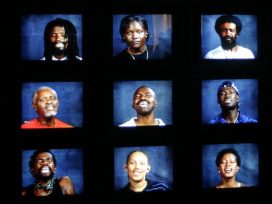Ord&Bild: The first question is straightforward: what makes the work of James Baldwin relevant today? Cultural, artistic and political perspectives are equally relevant!
Douglas Fields: The Irish writer Colm Tóibín wrote a piece in the London Review of Books twenty years ago in which he observed that ‘James Baldwin’s legacy is both powerful and fluid, allowing it to fit whatever category each reader requires, allowing it to influence each reader in a way that tells us as much about the reader as it does about Baldwin.’ Baldwin has become the most cited literary figure in the Black Lives Matter movement, underscoring ‘the tragically chronic relevance’ of the writer, as the New York Times put it. So maybe it’s indeed the case that Baldwin fills the void – whether that’s cultural or political – of a particular time; that his work speaks to – and sheds light on – the complexities and perils facing twenty-first century America and beyond.
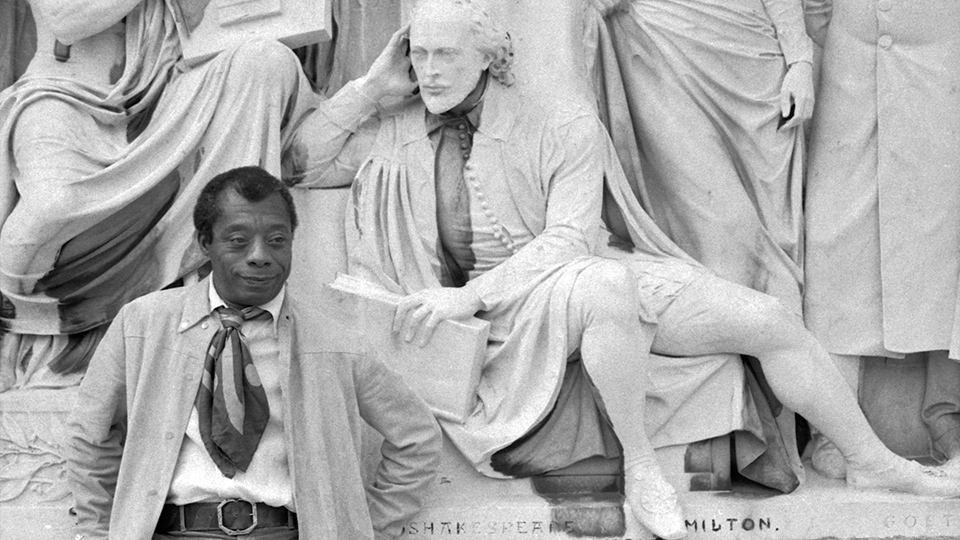
James Baldwin on the Albert Memorial with statue of Shakespeare. Photo by Allan Warren via Wikimedia Commons.
There is indeed something tragic about the continuing relevance of Baldwin’s work fifty years on. In the wake of the Ferguson protests in 2014, following the shooting of Michael Brown, Baldwin’s essays and interviews gained new traction across social media platforms. One interview in particular – ‘James Baldwin: How to Cool it’– first published in Esquire over fifty years ago, has attracted widespread attention. Responding to the interviewer’s claim that the police had demonstrated ‘a more permissive attitude’ to looters during recent riots, Baldwin replies, ‘I object to the term “looters” because I wonder who is looting whom, baby,’ adding, ‘you’re accusing a captive population who has been robbed of everything of looting. I think it’s obscene.’ Baldwin’s work frequently calls the logic of the law in question, pointing to the ways in which white power has incarcerated black Americans – mentally, physically, and psychologically; and so it’s not surprising to see how his work has been championed by the Black Lives Matter movement.
Black Lives Matter supporters have overwhelmingly resurrected an explicitly political public intellectual, primarily unearthing a 1960s-era Baldwin. He has become an icon, rather than a complex writer and perplexing figure. As the writer Teju Cole put it, Baldwin is the ‘go-to quote factory for those who are woke’. In August 2018, there were over 90,000 tweets referring to Baldwin. One of the most frequently tweeted Baldwin quotation is as follows: ‘To be black in America is to be in a constant state of rage.’ Far fewer tweets share his more complicated views on love and politics, such as his puzzling extortion in the 1960s that African Americans should accept people, ‘and accept them with love,’ or that ‘no one in the world … knows Americans better or … loves them more than the American Negro.’ And while Baldwin is often aligned with his inner-city upbringing, no one tweets about how it was Henry James’s novel The Princess Casamassima that helped him, in his words, to ‘break out of the ghetto’, or about his unfashionable emphasis on morality, which courses through his work.
On one level, I agree with Tóibín: Baldwin’s work allows readers to connect to his explorations of love, complexity, spirituality, queerness, Blackness – or whatever it is that draws them to this writer. And I think there’s truth in the claim that Baldwin – as black and queer – is embraced, at least in some circles, for the very reasons that he was shunned during his lifetime. But I also strongly believe that Baldwin’s work remains relevant because of his craft and unsurpassed eloquence, illustrated by clips of the writer talking on Raoul Peck’s film, I Am Not Your Negro. The film rightly points to the continuing relevance of Baldwin’s writing and speeches in twenty-first century North America, but it’s his eloquence and insight that draw people in. It’s hard to think of anyone today who speaks in paragraphs as Baldwin did; or who combines street-smart philosophy with a poet’s eye; or who unravels complexity with such eloquent economy in his interviews and writing.
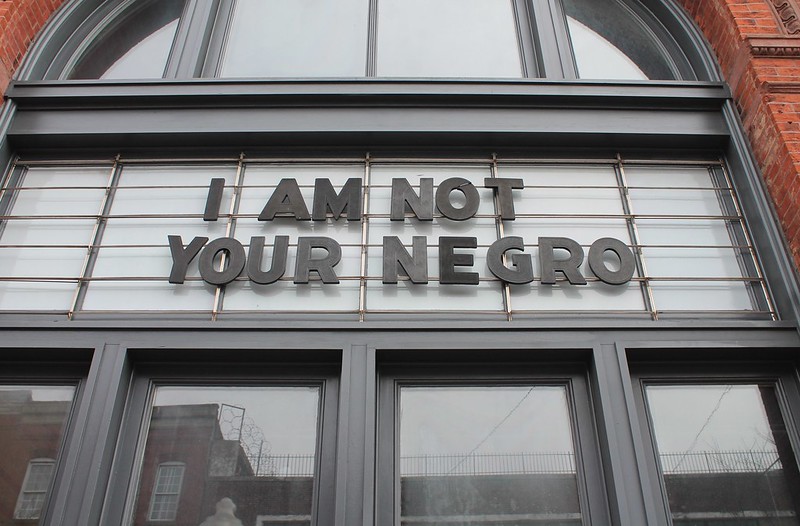
James Baldwin I AM NOT YOUR NEGRO docu-film marquee at The Charles Theater at 1711 North Charles Street in Baltimore, Maryland Photo by Elvert Barnes Photography from Flickr.
Justin Joyce: James Baldwin was a talented, sensitive man who lived through a paradigmatic change in our society and was brave enough to try to tell the truth about it. As he put it in the preface to the 1984 edition of Notes of a Native Son: ‘I am what time, circumstance, history have made of me, certainly, but I am also, much more than that. So are we all.’
Uncharacteristically short for Baldwin, in these lines we have a writer looking back after thirty years at his work – Notes was first published in 1955 – assessing his own relevance and place in history, attempting to be honest about what he was setting out to do when he took pen to paper and about the impact his work had had. It’s a seemingly simple notion, to look back at one’s work, but it’s wrought with Baldwin’s distinctive prose through qualifications and clauses that turn back on themselves in a reflexive and meditative style.
He was a talented writer, that much is obvious, and was a sensitive observer and dedicated chronicler of human complexity throughout work in numerous genres. Not content to comment only on race, Baldwin was also unabashedly writing of, and living, a sexuality that ran counter to the prevailing mores. What’s more, he was committed to the notion, as he put it, that ‘artists are there to disturb the peace’. He told the truth about things, as he saw it, and he wasn’t afraid to be outrageous or iconoclastic while doing so.
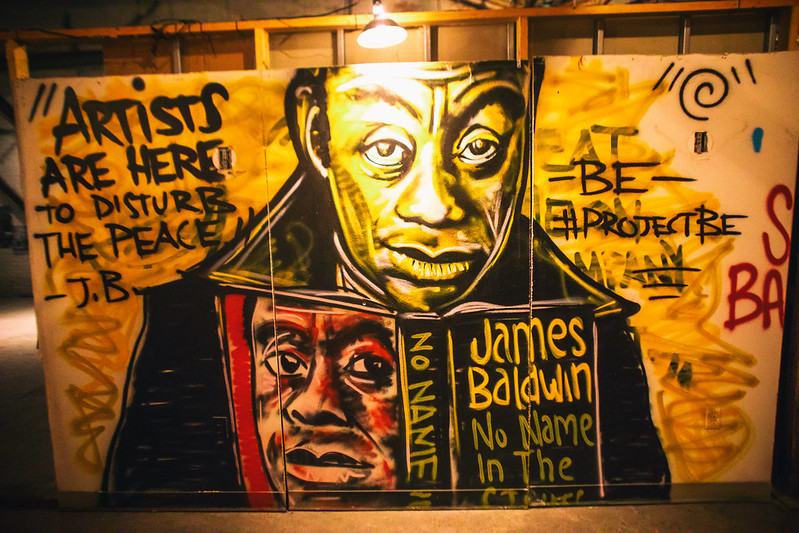
Photo by Thomas Hawk from Flickr.
The second line quoted above, to my reading, is part of what makes Baldwin’s style and example not just relevant, but urgent: his inclusive pronouns. The terse, ‘so are we all’ draws a reader in, implicates her in Baldwin’s musing and begs one to not just encounter Baldwin, but encounter their own self, life, works and legacies simultaneously. There are countless examples of this rhetorical sophistication and his shifty pronoun usage in his writings, in which ‘I’ quickly becomes ‘you’ or ‘we’, but this one brief example here demonstrates his power as a witness and a writer. In short, when one reads Baldwin, one is also ‘reading’, if you will, yourself; he draws you in, implicates you, makes you situate your own moral sense within the arc he traces. For this reason, Baldwin is not an ‘easy’ writer. Beyond his complex constructions, his style forces you to grapple not just with his work and his life, but with your own.
This combination of talent, sensitivity, and bravery is what made him relevant in his own time. As our racial politics and sexual mores continue to shift, it’s little wonder that many have claimed Baldwin as an icon. That he remains relevant today says as much about the slow pace of social, legal and economic change as it does about Baldwin as an individual artist.
Not unlike the long nineteenth century, there is a strong argument to be made that in many ways we are living through the ‘long’ 1960s. Born in the 1920s, Baldwin came of age in a racially segregated United States. While de jure segregation is no longer in place, de facto segregation is still very real in the US; and many of the other moral, social, and legal conundrums faced during the 1960s are still being grappled with today. His trenchant criticisms of policing and racial violence are obviously relevant in an age when we are again, and again, and again, reckoning with systemic anti-black racism and police violence.
As another example of the long historical arc of the civil rights moment, a movement Baldwin saw as having failed to achieve many of its objectives, we would do well to look at voter suppression initiatives currently being spearheaded by Republican legislatures in the US. As of May 2021, there are more than 360 bills at the state level aiming to make it more difficult for people to vote. That the obstacles to democracy envisioned by these bills disproportionately affect people of colour is, sadly, not surprising. In 1963 Baldwin participated in voter registration drives in the US South; these were grassroots initiatives mounted against entrenched white supremacy to expand the franchise and give more Black people the chance to exercise their constitutionally guaranteed right. Nearly 80 years later, the same fights over who gets a chance to participate in democracy – in the putative global ideal of democracy no less – are still being waged.
Ord&Bild: Maybe there is more to say about the complexity of Baldwin and his work that contrasts to what has been magnified in social media? But there might be something entirely different that you want to bring into the discussion.
Cora Kaplan: At the close of a revealing 1984 interview with Richard Goldstein, Baldwin was asked ‘Do you have good fantasies about the future?’ He replied, ‘I have good fantasies and bad fantasies.’ ‘What are some of the good ones?’ ‘Oh, that I am working toward the New Jerusalem. That’s true, I’m not joking. I won’t live to see it but I do believe in it. I think we’re going to be better than we are.’ He wasn’t asked, and didn’t elaborate on the ‘bad fantasies’, but in one of his last, and much less upbeat interviews with Quincy Troupe in 1987, he argued that in Ronald Reagan’s America, things were ‘worse’ than during Dr King’s time, that ‘the whole American optic in terms of the reality is based on the necessity of keeping black people out of it’. Reagan represented to white America ‘the justification of their history, their sense of innocence. He meant the justification of Birth of a Nation. The justification, in short, of being white.’
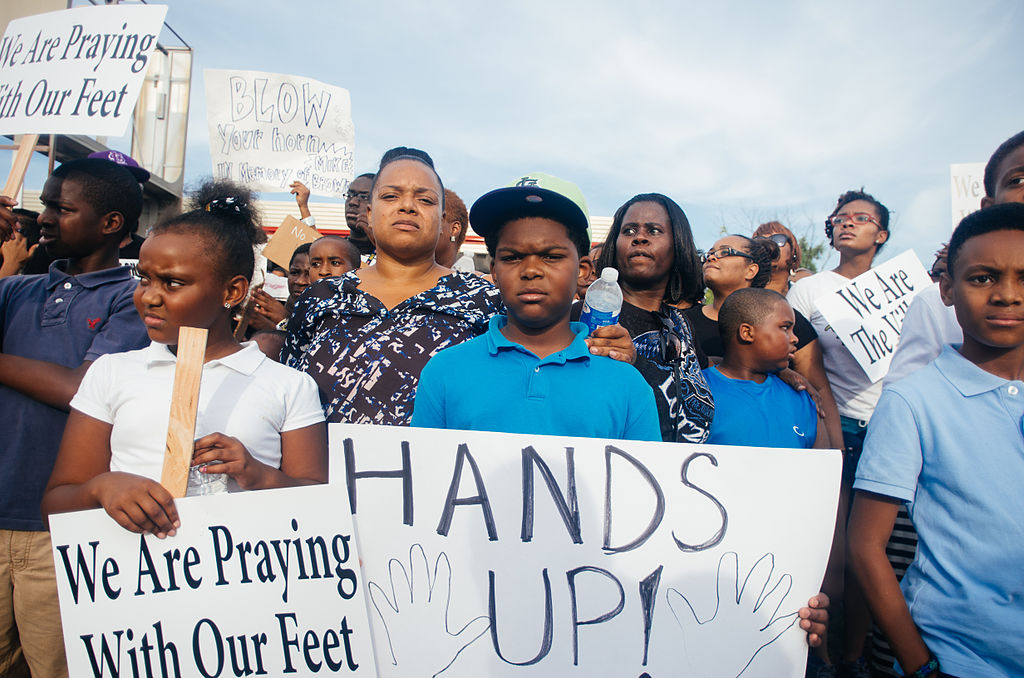
“Hands up! Don’t shoot!” signs displayed at Ferguson protests. Photo by Jamelle Bouie, CC BY 2.0, via Wikimedia Commons.
Certainly, since the Ferguson killing in 2014 and the exponential and now international rise of Black Lives Matter, both Baldwin’s optimism about people ‘being better than they are’ and his deep pessimism about an America whose racial ‘optic’ only changes for the worse, have been fully in view. BLM may have claimed the angry political, activist Baldwin as their historic spokesperson, at the expense of the more complicated and self-reflective figure that his work, life and legacy demand, but I believe that his public influence today is very various. To paraphrase the critic Raymond Williams’s comment about another self-made radical, Tom Paine: Baldwin imagined the audience he hoped to bring into being. That project, which embraces his fiction, plays, essays and always nuanced, eloquent public presence – all deeply connected and not to be disassociated – has succeeded.
In the decades immediately after his death, an underlying sense for many that he might be an important writer and political thinker whose time nevertheless belonged to the past has been superseded by the recognition that he is a living presence both on the page and visually. Obvious examples: without Baldwin, no Barry Jenkins’s Moonlight, never mind his adaptation of If Beale Street Could Talk. The black British playwright, Kwame Kwei Armah, now artistic director of the Young Vic theatre in London, credits Baldwin as a key influence.
Baldwin’s insistence that ‘the sexual question and the racial question have always been entwined’, together with his skewering of the psychopathology of white American masculinity, has never seemed more relevant. Even his radical ambivalence about ‘gay’ (not yet LGBT) rights as a movement, his dislike of binaries, and his sense that sexual preference is an inviolate right, but always a ‘private’ matter that should neither define nor restrict human identity, find resonance in evolving attitudes about sexual fluidity. His public ‘witness’ and even idealisation of same-sex love in his writing emboldened others. What was so troubling and problematic about this aspect of Baldwin’s work for some of the male Civil Rights and black power activists of his own and my generation in the 1950s and 60s also ‘disturbs’ – albeit differently – his readers and admirers today, as Baldwin thought all good and lasting writing must.
After his death, Toni Morrison famously said that Baldwin ‘made American English honest … ungated it for black people so that in your wake we could enter it, occupy it, restructure it in order to accommodate our complicated passion.’ And in the early 1990s black feminist poet Cheryl Clarke remembered that ‘reading Another Country made me imagine freedom from traditional monogamous heterosexuality … Another Country unsettled me forever and made me see the complexity of living as a sexual person’. That part of his legacy continues to insist.
Rereading, to answer the question, Notes of a Native Son, I am struck, as always, with the immediacy of Baldwin’s prose. The intimate and strategically exposing detail of his response to his father’s death is exemplary of that probing interiority he so admired in Henry James. His essays always begin, as Cheryl Wall has noted, citing Baldwin, ‘with the questions one asks oneself’, but widen inexorably, compellingly, to include other voices; a potent mix, as Wall says, of ‘literary and political critique, memoir and reportage’. The syncretic essay form that Baldwin took so far and so powerfully throughout his career has become a preferred, popular genre for the ideas and politics and the lived experience of many black writers and activists of the new millennium. He still speaks to us across time in his own person and voice, which we can see and hear with a click of the cursor on YouTube, as well as in Raoul Peck’s I Am Not Your Negro, and in the words, speech and actions of a new generation, which has appropriated and restructured Baldwin’s work for its own ‘complicated’ passions.
Justin Joyce: Cora’s wonderful point about Baldwin writing for an audience he hoped to bring into being got me thinking. Frustratingly, my answer here amounts to a sort of equivocation. Cora usefully points to his influence in many artistic media, and his relevance for current political issues. Despite the slow pace of social and legal change, it’s undeniable that numerous social mores that Baldwin railed against have shifted substantially since his death in the 1980s. I’m not generally a fan of discussions of Baldwin as a ‘prophet’, but in this particular instance of a fuller embrace of the complexity of humanity, I think it does make sense for us to locate and embrace James Baldwin at least as a progenitor or iconic example of how to live and to imagine the intersectional complexities of our lives and identities.
Just over twenty years ago, somewhere between Baldwin’s death and our current moment, Dwight McBride wrote in the introduction to his edited collection James Baldwin Now that, ‘with the advent of cultural studies, it is finally possible to understand Baldwin’s vision of, and for humanity in its complexity, locating him not as exclusively gay, black, expatriate, activist, or the like but as an intricately negotiated amalgam of all those things, which had to be constantly tailored to fit the circumstances in which he was compelled to articulate himself.’ Simply put, to be a complex, intersectional figure – unabashedly so – was a radical thing in Baldwin’s day, and it’s far more mainstream now. I think it’s especially astute of Cora to point out that Baldwin lived, spoke, and wrote with an imagined audience in mind that he hoped his work would help bring into being.
However, I worry over the utility of these complexities within our current media. On the one hand, the ubiquity of connectivity throughout the developed world means that more and more of us are sharing, and sharing more and more. While Baldwin was a brave truth-teller in his time, we are all ‘witnesses’ now; and nearly all the time. The advent of cultural studies may have helped pave the way for us to have a fuller grasp of a complex figure like Baldwin, but the advent of social media in the past decade has, I worry, diffused much of the power of his message. So much of our media is either based on snippets – tweets, posts, shares, likes, pins – or in direct competition with these bits of brevity. I don’t want to get too lost in laments here over the ‘commodification of dissent’, but it does seem apt to point out that there is a marketplace for Baldwin paraphernalia (hats, tote bags, tee shirts, candles, etc.) that exists in tandem with his utility as an icon in our current social media spaces. Within such a media and economic environment, the impact of Baldwin’s complex thinking and imagining is, unfortunately, often similarly clipped.
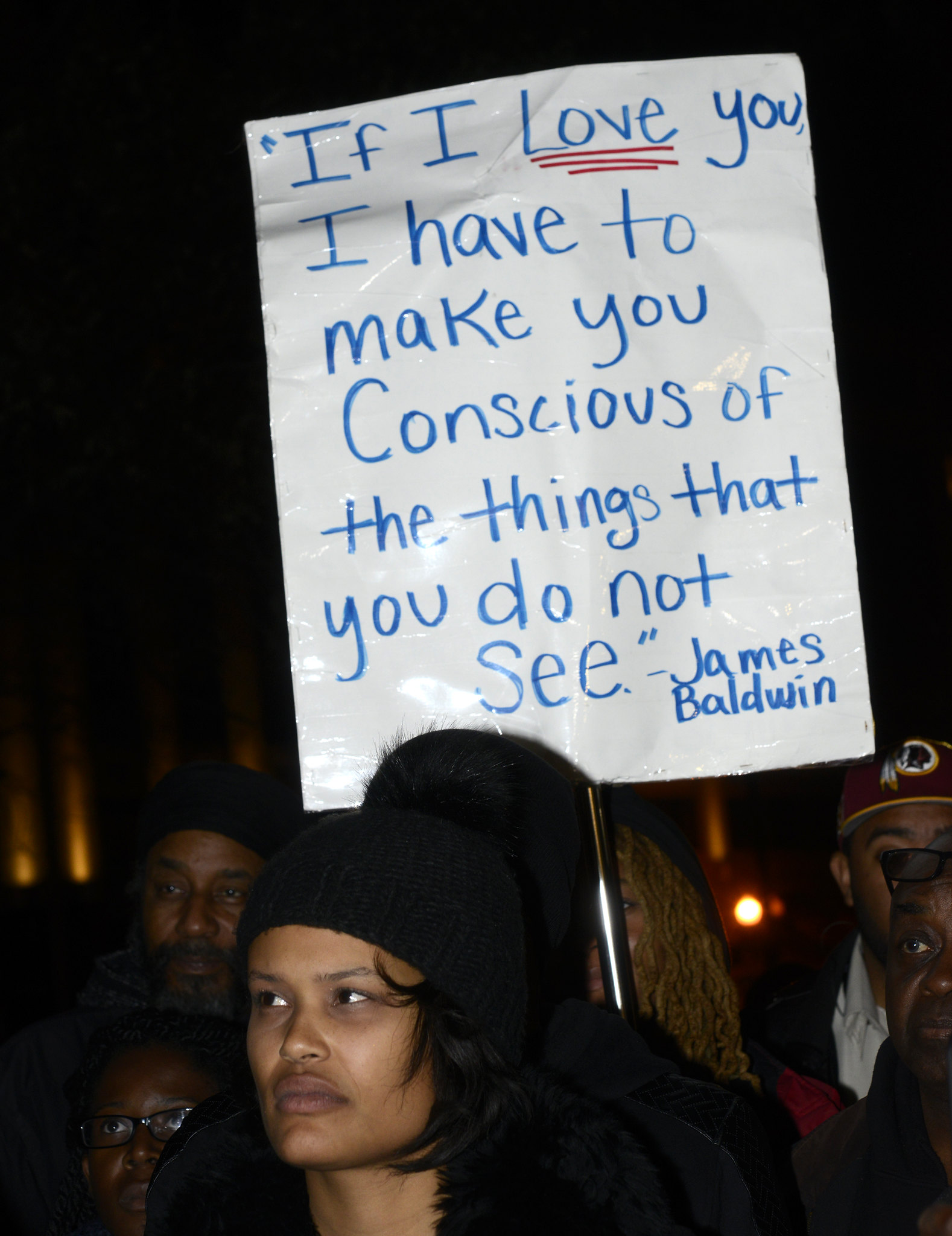
Photo by Stephen Melkisethian from Flickr.
Baldwin often wrote about love, but his notion of love was a complex, wrenching notion of acceptance born of confrontational truth-telling. One telling example of Baldwinian love: ‘I love America more than any other country in the world, which is why I insist on the right to criticize her relentlessly.’ A far cry from the sentimental conception of love regularly bandied about in popular culture, or the putative patriotism embodied in nationalist chants of ‘USA, USA’, Baldwin’s critical love is available on a T-shirt in a variety of colours and in every size. The data management firm, Domo, regularly releases a helpful infographic entitled ‘Data Never Sleeps’ and in the data compiled for 2019 we see that in every minute of every day the hashtag #love was posted 23,211 times. I’m not savvy enough to do the math, but that’s a lot of #love in a year, and I’ll hazard a pessimistic guess that precious little of it comported with Baldwin’s love as a ‘war, a battlefield, a growing up’. My worry is that context gets lost; and that the challenge he represented no longer upsets the status quo, but instead feeds the algorithm.
Cora Kaplan: Like you, Justin, I’m wary of making Baldwin or any other thinker or writer into a prophetic voice, anticipating a future rather than speaking from and to their complicated moments. On the marketization of radical events and figures, I once heard Angela Davis – speaking, many years back, in London – muse on the chilling effect of seeing her younger face and big Afro on T-shirts. I agree with you about Baldwin’s complicated idea of love and its uses – ‘wrenching’ is just right, whether the love is for family, persons or country. His use of the word was often misunderstood and trashed as sentimental in his own time and by his peers.
Among Baldwin’s admirers in his lifetime there was a generation and more of women readers coming of age in the 1960s and 1970s, emerging feminists, black and white, who would find both the essays and the novels liberating, even if sometimes, as Cheryl Clarke says, they had to read his fiction ‘against the grain’, identifying perforce with an idealised homoeroticism rather than with his more troubled depictions of heteronormative women. His critique of macho American white masculinity touched on an issue that would resonate with women on many levels, a critique whose full force was perhaps not felt until the flowering of second wave feminism in the late 1960s and 1970s. The long arc of the 1960s protest movements bends to the present widespread outcry against sexual harassment and worse in the workplace and public life. In the 1990s feminists like Lynne Segal in her popular book, Slow Motion: Changing Masculinities, Changing Men (1990) credited Baldwin as ‘one of the most powerful and persuasive male commentators on white American masculinity over the past three decades’. Just as eye-opening and influential for feminist writers and thinkers down the decades, I believe, has been the way in which the personal and political, the racial and the sexual, are juxtaposed, combined, and elided in Baldwin’s essays – becoming, perhaps through many mediations, the hybrid form of choice for today’s political memoir.
